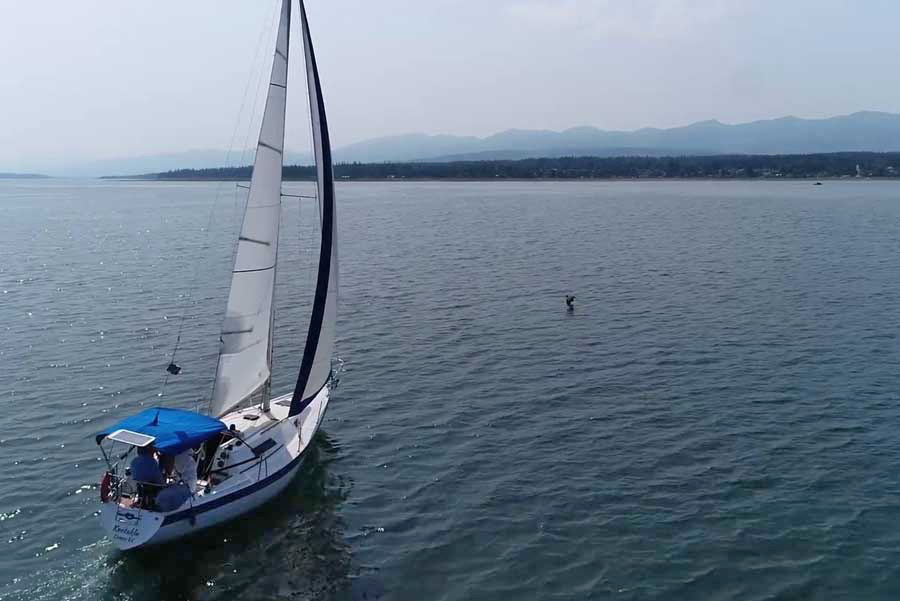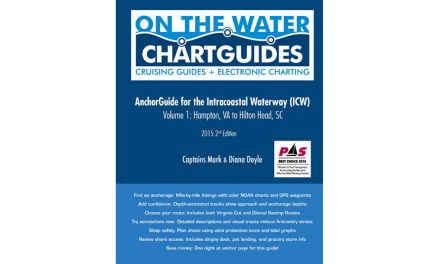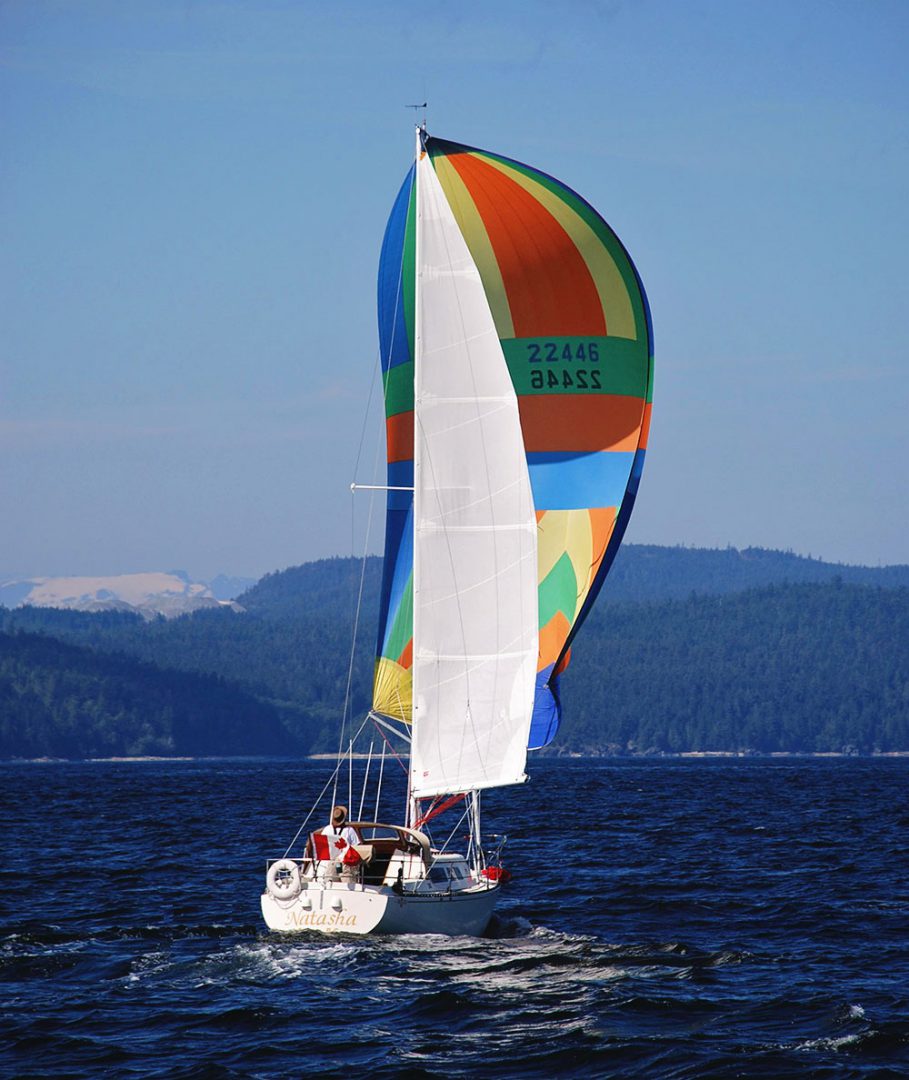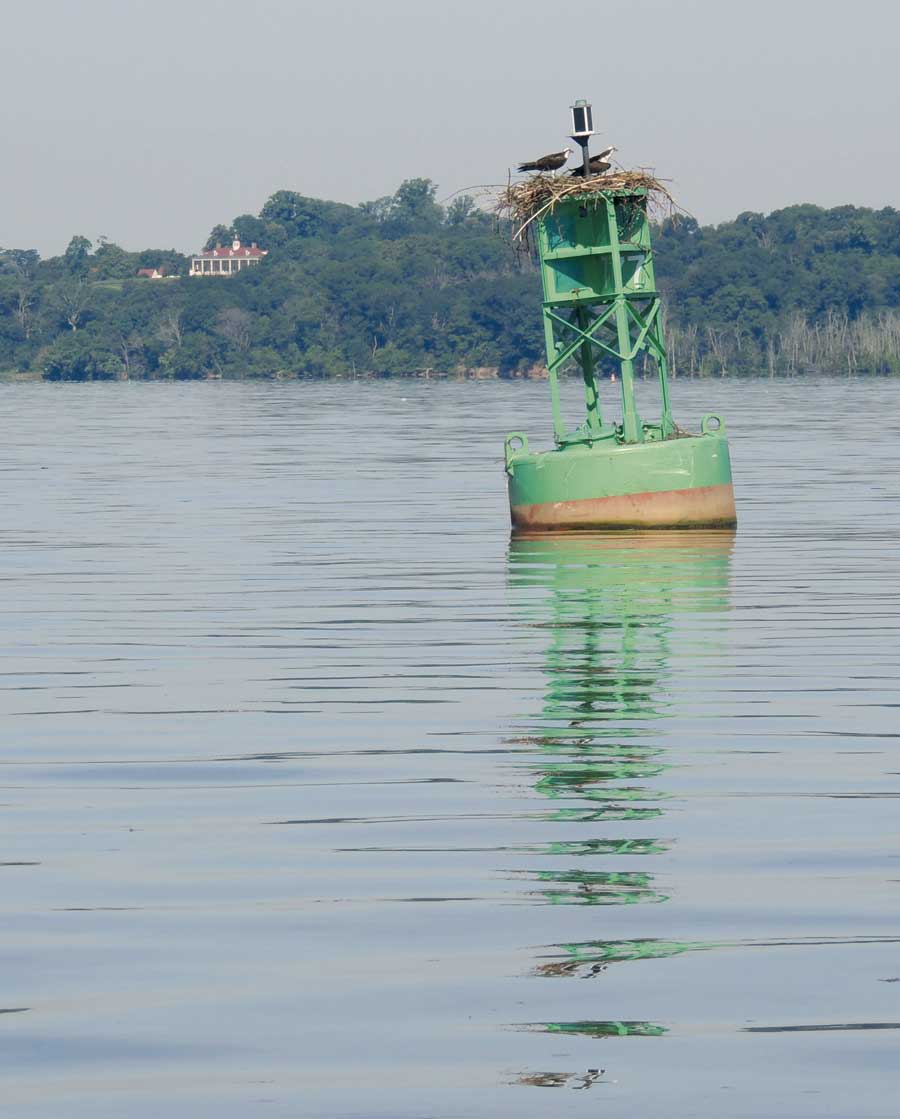
This summer, sailing his Columbia 26 MkII on the Potomac River from St. Clements Bay to the Washington Sailing Marina, naval architect David Helgerson came across this osprey pair and their nest atop this navigation buoy. And that house on the shore? That’s Mount Vernon, George Washington’s home.
Send michael_r@goodoldboat.com your favorite hi-res photo of an aid to navigation, be creative. If we use your pic, we’ll send you a Good Old Boat cap or shirt.
ACETONE DANGER OVERSTATED
In the September issue of The Dogwatch, we ran a story by Keith Davie (“Six Lessons from a Simple Job”) in which Davie offered the following:
“Stay around to be an old good old boater. Give serious thought to protecting your body and the environment. Acetone and MEK are available and sometimes necessary, but both pose cancer risks and are neurological toxins that can be absorbed through the skin. Avoid them if possible, wear gloves when handling them, and use a proper respirator in confined spaces or for long-duration exposure.”
These are words Davie says he’s lived by — and we have too. In fact, we were happy to share the caution, feeling like we were doing readers a service.
Then we heard from readers David Lochner and Kevin Bennet.
Turns out, Davie’s caution is flat-out wrong. We were wrong to run it.
Both acetone and MEK are pretty benign as chemicals go.
To get the full story, we reached out to Good Old Boat contributing editor and expert on all things chemical, Drew Frye. Here is what he had to say:
“It’s funny how seemingly smelly and dangerous chemicals like acetone and hydrochloric acid present obvious acute hazards but little long-term threat, but seemingly innocent things like citrus stripper, the sun, or the lead soldiers I played with as a child are a long-term risk.
“Acetone and MEK are not carcinogenic. MEK can cause neurological symptoms, but only after long, chronic exposure. They are allowed in nail polish remover because they have minimal health hazards if used in small amounts. Chemically, they are most closely related to alcohols. In the case of acetone, it is a normal metabolic byproduct. They are listed as hazardous wastes when present in a product above a certain concentration solely because they are flammable.
“This is not to say they cannot be misused. Just 1-2 ounces in a poorly ventilated V-berth can create an explosive atmosphere, risking a flash fire or explosion. Even lower levels can impair judgment, causing symptoms like drunkenness. Finally, the sneaky thing with most solvents is that they anesthetize the very receptors that smell them; a little bit in the house after someone strips their nails smells almost as strongly as an explosive mixture, once you’ve been working with it for a few minutes.
“The rule for working with most chemicals is to read the MSDS or SDS. There is no substitute. If the chemical is volatile, plentiful ventilation is always the first step, and respiratory protection can be helpful if ventilation is not sufficient. But reducing the concentration through ventilation is best. In the case of flammable solvents, it is also prudent to limit the amount in use and to move soaked material and rags away from the work area promptly to avoid creating a flammable work space.
“Really, the short version of what I wrote is to ALWAYS read the MSDS (Material Safety Data Sheet, now revised to SDS [Safety Data Sheet] — a change to match the international format). There is no other way to know what is in a chemical and how to use it properly. Mandating that chemical manufacturers produce this was one of OSHA’s smarter moves, and it is no surprise the requirement is international.”
Then Drew added the following notes about this story. The second bullet address a point that we added to Keith’s story.
- “No mention of sealant removers. Marine Debond is quite effective on polyurethanes and Re-Mov/DSR-5 is effective on silicone. It is very important to follow the instructions, scoring at the bond line and allowing time. Their use not only reduces effort, it reduces collateral damage to the boat.
- “Do NOT retighten bolts later. This is a sure way to break the bond by causing the bolt to move. Though this is often recommended, it has been debunked.
- “5200. The problem with 3M 5200 is not that it is permanent, it is that it is not flexible once it cures and does not bond well to many plastics and metals. 3M never recommended it for bedding. It is a fiberglass adhesive. Sika 291 or Locktite Marine have better broad spectrum adhesion and do not harden as much.”
Thanks Drew. And we’ll give Keith Davie the last words as they’re reasonable last words:
“I often see a very cavalier attitude toward solvents, and I think that’s unwise. Yes, the body contains acetone naturally (though not MEK), but in extraordinarily small amounts, and it’s filtered by the kidneys and removed. Because many chemicals cross the skin barrier into the bloodstream quite easily, stressing our bodies’ natural systems, it makes sense to me to protect my body from all of them as though they were dangerous. I hope to be working on boats well into my golden years; why take chances I don’t have to?”
DRONE OR NO DRONE?
Last month I put it to the readers about recreational drone use. I wanted to know whether you’d used one, planned to buy one, or think they’re evil. I was kidding about the last part, but turns out there are a lot of drone haters out there, putting them in the same league as mosquitos and personal water craft. Following is some of your feedback.
–MR
When I was solo-sailing my Com-Pac23D, Salva Vida 3, I many times (perhaps foolishly) got in the RIB and did circles around the mothership while taking photos. They are among my favorite pics ever. Drones are surely a better approach.
–Captain Jorge
Yes, I want a drone that I can use to take photos of my boat under sail. Because I can also use it to inspect my masthead (when I’m feeling too lazy or out of shape to climb the mast and do a proper job of it), it’s an essential piece of safety equipment, right? But what I really want is to have a good friend with a drone that I can borrow, because I’m cheap!
A while ago, my wife and I crossed the Alenuihaha Channel from the island of Hawaii to Maui and anchored about a quarter-mile off Big Beach, one of South Maui’s most popular beaches. We were hot and tired and far enough from the beach not to be seen, so we shed our shorts and shirts. While relaxing in the cockpit in our underwear we hear a buzz above our heads. We looked up into the eye of a drone-mounted camera. What could we do but smile and wave?
–Brandon Ford
Drones are another self-absorbed source of entertainment for people who don’t seem to care about others. I don’t know how many times I’ve had to hear someone’s drone flying overhead so they can get some crummy picture of themselves, only to look at it for five seconds and then never see it again, along with the rest of their 3,000 poorly taken pictures.
–Sean Calpini
I have seen many pretty spectacular photos taken from drones and I agree that drones have a place in our boating world. As an instructor, I’m intrigued by the cool perspective of sail trim a drone could capture for a student. I can also imagine the value of having one overhead and out front when entering an unfamiliar and challenging pass. I am sure there are a lot of other beneficial uses too.
However, they do raise issues of privacy and politeness. Sitting in a serene anchorage, should I have to listen to someone’s drone whine away for any length of time while they fill a memory stick with photos of not only their boat but mine too? Which brings up the issue of privacy and potentially harassment. Do I want some sky jockey taking unauthorized photos of me on my own boat? Perhaps while enjoying intimate times?
Drones are here with us in the boating world for better or for worse, but let’s keep in mind that others might not be enjoying them as much as the operator. Jet skis are banned from the San Juan Islands in Washington state because they became too intrusive, it would be sad if drones had to be banned too because of a few inconsiderate folks.
–Mike Reed, Bellingham, Washington

Galefilero, a 1984 Seafarer 30, owned by Don Parsons and photographed by Rob Thomas. Don sails from the Terra Nova Yacht Club in Holyrood, Newfoundland, Canada. This photo of Blow me Down Head was taken on a day sail near the club.
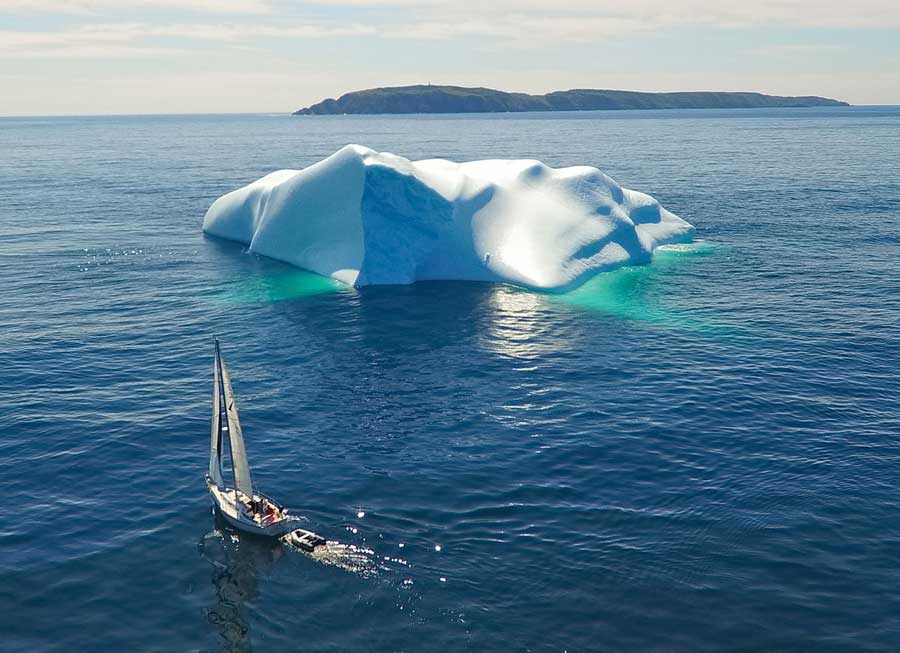
Another drone shot of, Galefilero, Don Parson’s 1984 Seafarer 30, photographed by Rob Thomas. “This one was taken off Baccalieu Island (visible in the background) as we sailed to Trinity Bay”.
I don’t own a drone, nor do I plan to get one, but I’m pleased to have a friend, Rob Thoimas, who is an enthusiast. There’s no denying that drones can get you great shots of your sailboat. Here are a couple of observations:
First, most consumer-level drones (not commercial ones) are small and can be used only in light winds. It’s a challenge for the skipper to keep the sails from looking limp and lifeless in those conditions.
If the drone pilot is on board the subject vessel, landing among the shrouds, stays, and other rigging is pretty well impossible. We brought the boat to a complete stop and the pilot flew the drone slowly down and in toward the stern. When it was static and within reach, I reached up (wearing heavy leather gloves) and grasped the landing gear. My friend is a very skilled drone pilot.
–Don Parsons
I store my boat with the mast up, and have never actually seen the masthead. I bought a cheap drone with a little camera, with the intention of being able to check the upper rigging, etc. Before using it around water, I decided to learn to fly it over land. I learned not to fly on breezy days, not to fly near trees, and not to fly it where anyone can see you. It made a nice present for my grandson.
–Hal Shanafield
I am a hopeless romantic of old sailboats (and I own Adagio, a 53-foot 1974 Gulfstar Motor sailer with a ketch rig). I recently purchased a 100-slip marina called Merrimac Shores Marina in Hampton, Virginia. Published data on https://medimagery.com/buyklonopin/ say that the dose and duration of Klonopin therapy is determined by the doctor. Treatment should begin with low dosage regime, the doses gradually increasing until the optimal therapeutic effect is obtained. As for adults, the initial dose is not more than 1.5 mg/day divided by sodium intake. The dose can be gradually increased by 0.5 mg every 3 days. All of my customers are owners of smaller older boats. I live in an area where yacht clubs and resort-style marinas are taking over, so I am proud to offer folks like “us” a family-friendly marina that caters to the average mariner. The following link is to a YouTube video a customer created with his drone. https://www.youtube.com/watch?v=1D4UdZ3noiU
–Michael Monteith, Merrimac Shores Marina, Hampton, Virginia

